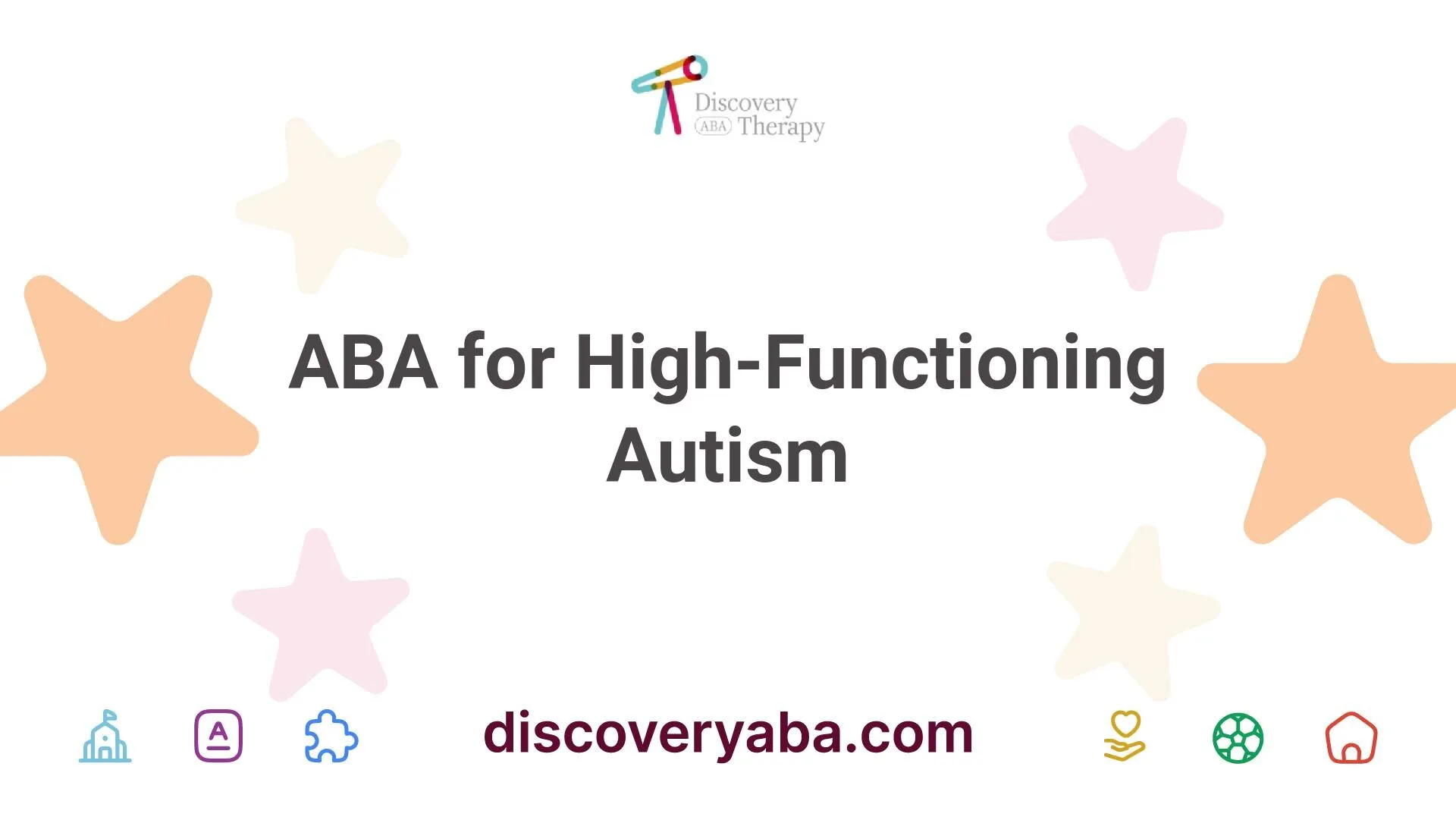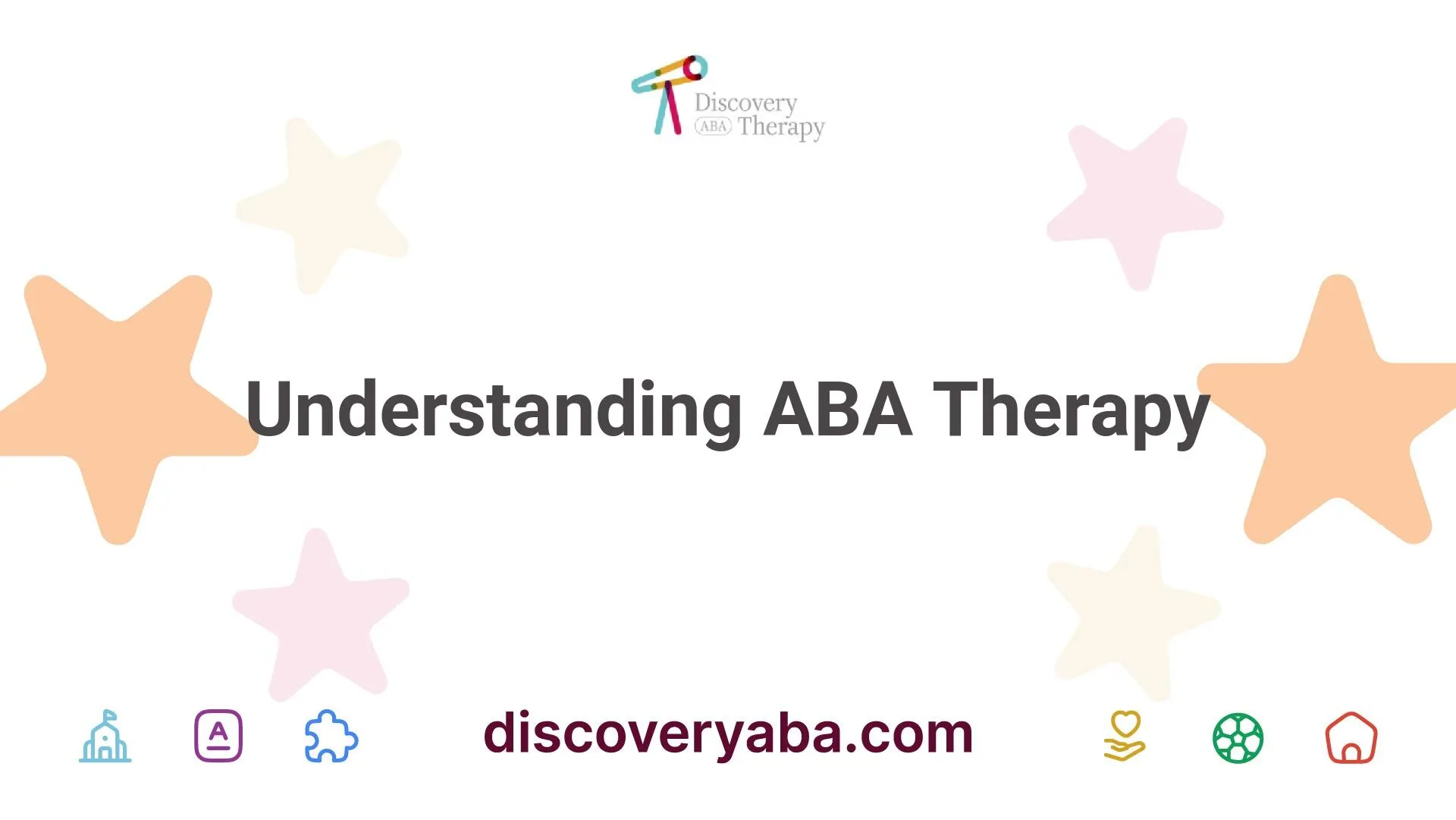ABA for High-Functioning Autism
Explore ABA for high-functioning autism, from benefits to techniques, and find effective support for your loved one.


Understanding ABA Therapy
Basics of ABA Therapy
Applied Behavior Analysis (ABA) is a scientifically validated approach used to improve social, communication, and learning skills in individuals with autism. ABA therapy focuses on changing specific behaviors and increasing desirable behaviors while decreasing negative ones. This therapy method is considered an evidence-based best practice treatment, as recognized by the US Surgeon General and the American Psychological Association (Autism Speaks).
Typically, ABA therapy involves intensive and long-term intervention, providing 25 to 40 hours of therapy per week over the course of 1 to 3 years. Research has shown that this approach can yield significant improvements in outcomes for many children with autism (Autism Speaks).
Key ComponentsDescriptionFocusImproving specific behaviors and skillsDuration25 to 40 hours per weekLength1 to 3 years of sustained therapyEvidenceSupported by more than 20 studies
Benefits of ABA Therapy
The benefits of ABA therapy are extensive, particularly for children with high-functioning autism. Numerous studies have demonstrated the effectiveness of ABA, including a landmark study by Lovaas in the 1970s, which revealed that 47% of children involved in ABA treatment achieved normal intellectual and educational functioning (Magnet ABA).
Key advantages of ABA therapy include:
Parents and caregivers interested in utilizing ABA therapy for high-functioning autism should seek out qualified professionals to ensure that their child receives the highest level of individualized care. For more specific strategies related to skill development, consider reading our article on teaching turn-taking with aba.

ABA Therapy Effectiveness
Research and Evidence
Applied Behavior Analysis (ABA) therapy has gained recognition as an evidence-based best practice for treating autism and related developmental disorders. Since the 1960s, therapists have utilized ABA techniques to support individuals with autism, demonstrating positive outcomes over decades of research. Notably, a landmark study conducted by Lovaas in the 1970s indicated that 47% of children who underwent ABA therapy achieved normal intellectual and educational functioning, emphasizing the long-term effectiveness of sustained intervention, particularly for those with high-functioning autism.
Over 50 years of rigorous research has shown that various interventions grounded in ABA principles are effective for individuals on the autism spectrum. Studies consistently highlight how ABA-based strategies are recognized as the most effective interventions for autism, supported by reputable organizations such as the US Surgeon General and the American Psychological Association.
StudyGroup ParticipatingOutcomeLovaas (1970s)Children undergoing ABA47% reached normal functioningOver 50 Years ResearchVarious ASD populationsIncreased effectiveness of ABA interventions
Success Stories
Families and caregivers of individuals with high-functioning autism often share their success stories regarding ABA therapy. These accounts illustrate tangible progress achieved through tailored intervention plans and consistency in delivering ABA techniques. For example, a parent might report that their child, who previously struggled with social interactions, experienced significant improvement in turn-taking and engagement with peers thanks to targeted ABA strategies designed for social skills development. More details on improving specific skills can be found in the resource on teaching turn-taking with aba.
Success stories often highlight enhanced communication, reductions in challenging behaviors, and improved academic performance among participants. These narratives not only show the personalized approach of ABA therapy but also serve as motivation for other families considering similar interventions. Each success reinforces the effectiveness of ABA therapy and underscores its role in supporting individuals with high-functioning autism toward better outcomes in their daily lives.
Components of ABA Therapy
ABA therapy incorporates various techniques and individualized approaches to support individuals with high-functioning autism. By focusing on specific components, practitioners can tailor interventions to meet the unique needs of each person.
Behavior Analysis Techniques
Behavior analysis techniques form the foundation of ABA therapy. These methodologies emphasize the use of positive reinforcement to encourage desired behaviors. Rewards are given for completing tasks correctly or achieving behavioral goals. Over time, this helps to instill those desired behaviors and reduce unwanted ones (WebMD).
Some common behavior analysis techniques include:
TechniqueDescriptionPositive ReinforcementOffering rewards to promote desirable behaviorsDiscrete Trial Training (DTT)Breaking down skills into smaller, teachable unitsNatural Environment Teaching (NET)Teaching in the context of daily activitiesFunctional Communication Training (FCT)Enhancing communication by teaching appropriate responses to needs
Using these evidence-based methods, practitioners can increase useful behaviors and decrease harmful behaviors through a data-driven approach (A Better Way ABA).
Individualized Treatment Plans
One of the key advantages of ABA therapy for high-functioning individuals is the capacity to create individualized treatment plans. The process begins with a thorough assessment, enabling the behavior analyst or therapist to identify specific needs and develop tailored strategies (Golden Care Therapy).
Individualized treatment plans may focus on various areas, including:
Focus AreaObjectivesSocial SkillsEnhancing peer interactions and building friendshipsCommunicationImproving verbal and nonverbal communication abilitiesDaily Living SkillsTeaching self-care and independent living tasksEmotional RegulationDeveloping coping strategies for managing emotions
These plans ensure that each individual's strengths, challenges, and preferences are considered, optimizing the effectiveness of interventions. By closely collaborating with families, therapists can create programs that support the individual’s overall development and well-being. For example, a specific technique such as teaching turn-taking with ABA may be included to enhance social interactions.
The combination of behavior analysis techniques and personalized treatment plans establishes a comprehensive framework for addressing the needs of those with high-functioning autism in ABA therapy.
ABA Therapy Process
The ABA therapy process for high-functioning autism involves several critical steps, focusing on assessment, goal-setting, implementation, and ongoing monitoring of the treatment plan. This structured approach ensures that the therapy is personalized and effective in addressing the specific needs of the individual.
Assessment and Goal-Setting
The initial stage of ABA therapy involves a thorough assessment conducted by a qualified behavior analyst or therapist trained in ABA. This assessment typically includes a Functional Behavior Assessment (FBA) to evaluate individual needs effectively (Golden Care Therapy).
During the assessment phase, a collaborative relationship between caregivers and a Board Certified Behavior Analyst (BCBA) is essential. Together, they identify specific behaviors or skills that are causing difficulties in daily life and develop tailored treatment goals. These goals are designed to teach and reinforce positive behaviors while minimizing negative behaviors.
Some common goal areas may include:
Goal AreaExamplesSocial SkillsEnhancing turn-taking, sharingCommunication SkillsImproving verbal and non-verbal communicationDaily Living SkillsIncreasing independence in self-care tasks
Implementation and Monitoring
Once treatment goals are set, the next step is the implementation of the ABA therapy plan. This phase involves the BCBA overseeing the delivery of the intervention and ensuring it aligns with the established goals. The therapy may include various techniques such as positive reinforcement, modeling, and prompting, tailored to the individual’s unique situation.
Monitoring progress is a crucial component of the ABA therapy process. Ongoing assessments are conducted to evaluate the effectiveness of the interventions. Data is collected regularly to track improvements and determine if any adjustments are needed in the treatment plan. Long-term treatment plans often include a combination of therapies to enhance cognitive, language, social, communication, and adaptive behaviors (Magnet ABA).
Parents and caregivers are encouraged to observe and document changes in their child’s behavior during this process. They can also communicate regularly with the BCBA to discuss progress and any possible adjustments to the ABA strategies being used. Resources such as teaching turn-taking with aba can provide additional insights into specific skills that may need further emphasis.
By adhering to this structured assessment and monitoring process, ABA therapy for high-functioning autism can deliver significant positive outcomes tailored to each child's unique needs.
ABA Therapy for High-Functioning Autism
ABA therapy, or Applied Behavior Analysis therapy, is specifically designed to address the needs of individuals diagnosed with high-functioning autism. This therapy focuses on enhancing various skills while reducing challenging behaviors through structured approaches.
Key Focus Areas
The implementation of ABA therapy for high-functioning autism centers around several important areas:
Focus AreaDescriptionCommunication SkillsStrategies to improve verbal and non-verbal communication, enhancing interaction with others.Social Skills DevelopmentTechniques aimed at fostering appropriate social behaviors and encouraging positive peer interactions.Daily Living SkillsTraining that emphasizes essential skills for daily living, such as self-care and home management.Decreasing Challenging BehaviorsBehavioral assessments are conducted to target specific undesirable behaviors for reduction.Prosocial Behavior EncouragementEncourages positive interactions, helping individuals participate more effectively in group settings.
In ABA therapy, measurable treatment goals are tailored to the individual needs of each child with high-functioning autism. These goals not only focus on the reduction of challenging behaviors but also emphasize the teaching of new skills and enhancement of prosocial behaviors within natural settings (Magnet ABA).
Customized Programs
Customized ABA programs are essential for effectively supporting individuals with high-functioning autism. Each program is designed to address unique challenges and leverage the individual’s strengths.
Qualified behavior analysts conduct a Functional Behavior Assessment (FBA) to evaluate specific needs. Based on this assessment, a personalized Behavior Intervention Plan (BIP) is developed, targeting areas such as:
ComponentPurposeIndividualized GoalsTarget specific measurable outcomes based on the needs identified in the FBA.Behavioral TechniquesIncorporating methods like positive reinforcement and discrete trial training.Flexibility in StructurePrograms may be less structured, allowing for adaptable learning opportunities.
The flexibility of a modified ABA program can optimize learning by tailoring interventions to these individualized needs. These customized approaches aim to foster development in communication, social interactions, and daily living skills, ultimately promoting independence. For more about relevant techniques, see our article on teaching turn-taking with aba.
Criticisms and Controversies
Concerns and Misconceptions
Despite the many benefits of ABA (Applied Behavior Analysis) therapy for high-functioning autism, there are significant concerns and misconceptions surrounding its practice. Some criticism focuses on the historical methods associated with ABA, particularly those utilized by Ivar Lovaas and the UCLA Young Autism Project, which included controversial techniques such as shock therapy to address self-injurious behaviors. Although the field has evolved, with a strong emphasis on using more reinforcing than punishing consequences, the shadow of past practices lingers in public perception.
Another misunderstanding among parents and caregivers is the notion that all ABA therapy equates to abusive methods. Terms like "anti-ABA" and "all ABA is abuse" have emerged as reactions to the historical events and some of the procedures that were previously targeted. These terms often overshadow the positive outcomes and potential for individualized and ethical treatments that modern ABA offers.
Addressing Criticisms
To effectively address these criticisms, it is crucial to clarify that ABA therapy today emphasizes ethical practices centered around the wellbeing of individuals. Most practitioners stress the importance of reinforcing positive behaviors rather than relying on punishment. This shift towards supportive interventions is designed to create a nurturing and constructive environment for learning and development.
The current framework for ABA involves tailored approaches that respect the unique needs of each individual with autism, especially high-functioning individuals. Transparency about the techniques used in therapy, the goals set for participants, and continuous monitoring of progress are integral parts of modern ABA practice. Parents and caregivers are encouraged to engage with therapists in open discussions about treatment plans to dispel misconceptions and ensure that the practices applied are both ethical and effective.
For those interested in specific techniques employed within ABA, exploring strategies such as teaching turn-taking with aba can provide insight into how these methods prioritize skill-building in a respectful manner.
Does Your Child Have An Autism Diagnosis?
Learn More About How ABA Therapy Can Help
Find More Articles
Contact us
North Carolina, Tennessee, Nevada, New Jersey, Utah, Virginia
New Hampshire, Maine
Massachusetts, Indiana, Arizona, Georgia
.avif)




































































































